PAKISTAN
Fierce Face-off
By Jenny McGlone
Chapel Hill, NC, United States
What defines a nation? Is it simply a matter of geography? To what extent do common languages, cultures, religions, and politics make a difference when establishing borders?
These were questions faced by the leaders of British India in the middle of the 20th century. For many years, the Muslim and Hindu religious communities coexisted, but under British rule the two groups fractured. When violence erupted, Great Britain agreed to separate the subcontinent into two countries, one Muslim and one Hindu.
Partition
This 1947 separation, known as a “partition,” created the independent nation of Pakistan from two Muslim-majority provinces in the northwest, as well as one in the east. The remaining land formed a new, autonomous India, governed by a Hindu-dominated legislature. The next difficult decision was where exactly to draw the border between Pakistan and India?
A British lawyer named Cyril Radcliffe was chosen to find the answer to this question. He spearheaded a commission that, in five short weeks, drafted a map seeking to distribute religious groups equally. The new Pakistan-India border became law on August 17, 1947.
Migration Crisis
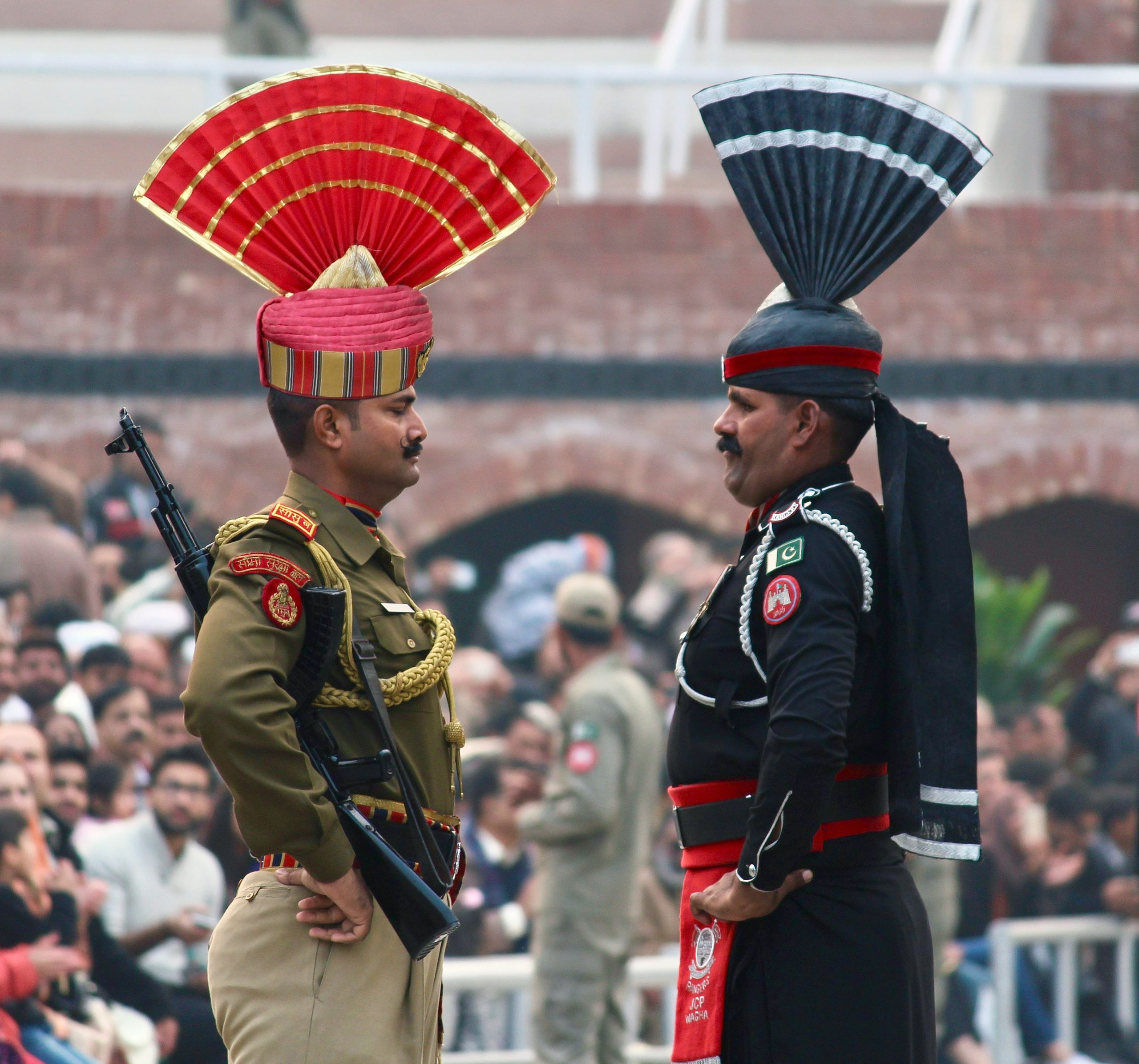 When the Radcliffe Line was made official, an estimated 14 million people found themselves on the “wrong” side—Muslims in India and Hindus (mostly, but also Sikhs and Buddhists) in Pakistan. Because of so much previous conflict, people did not feel safe belonging to a minority group. The resulting scramble for refuge turned into a violent mass migration that lasted for months and cost more than one million lives.
When the Radcliffe Line was made official, an estimated 14 million people found themselves on the “wrong” side—Muslims in India and Hindus (mostly, but also Sikhs and Buddhists) in Pakistan. Because of so much previous conflict, people did not feel safe belonging to a minority group. The resulting scramble for refuge turned into a violent mass migration that lasted for months and cost more than one million lives.
Since that crisis, tensions between Pakistan and India have risen and fallen over time. The two countries have sparred over the region of Kashmir and the nation of Bangladesh. One unique outcome of this long-standing friction can be witnessed every day at a border crossing on the Radcliffe Line.
Putting the Flags to Bed
At a location 600 meters east of the village of Wagah, Indian and Pakistani security forces have participated in a flag-lowering ceremony since 1959. Officially known as Beating the Retreat, it begins just before sunset with a precisely choreographed parade of soldiers from both countries. The pageantry draws thousands of tourists who marvel at the specially trained soldiers’ impressive high kicks and goose-stepping marches, all set to drum beats.
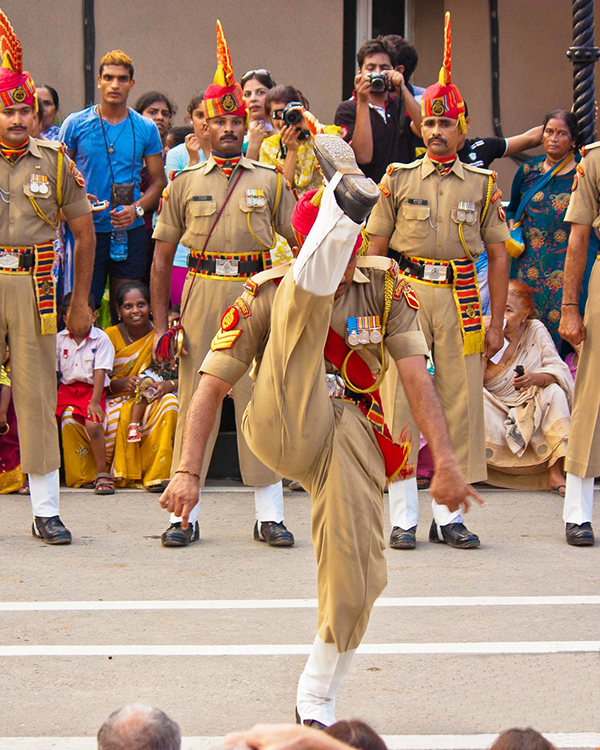 Plume-adorned hats, elaborate uniforms, swinging fists, and scowling faces create an intimidating spectacle. Patriotic chants reverberate from loudspeakers, eliciting shrieks and applause from the audience. There’s even a rumor that the male soldiers are paid extra to maintain thick mustaches!
Plume-adorned hats, elaborate uniforms, swinging fists, and scowling faces create an intimidating spectacle. Patriotic chants reverberate from loudspeakers, eliciting shrieks and applause from the audience. There’s even a rumor that the male soldiers are paid extra to maintain thick mustaches!
The ritual terminates with the Indian and Pakistani flags descending from atop their poles at exactly the same speed. After the flags are carried away, a brisk handshake between the two parade leaders seals the transaction. Then the border gates roll closed for the night.
Despite the stern showmanship, the ceremony’s atmosphere is festive. Visitors dance to Bollywood music before taking their seats in the stadium. Afterwards, they take selfies with the soldiers on both sides. The show is not only a marvel of entertainment but also a symbol that cooperation can be possible even between historic foes.
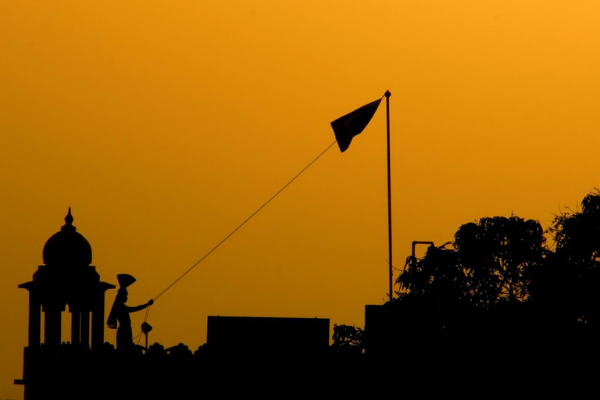
Have a suggestion for this story? We’d love for you to submit it!
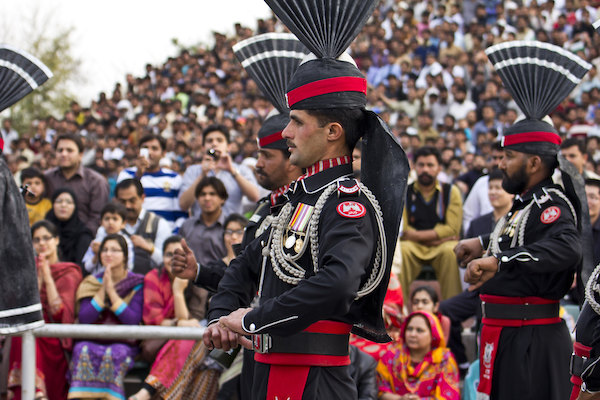
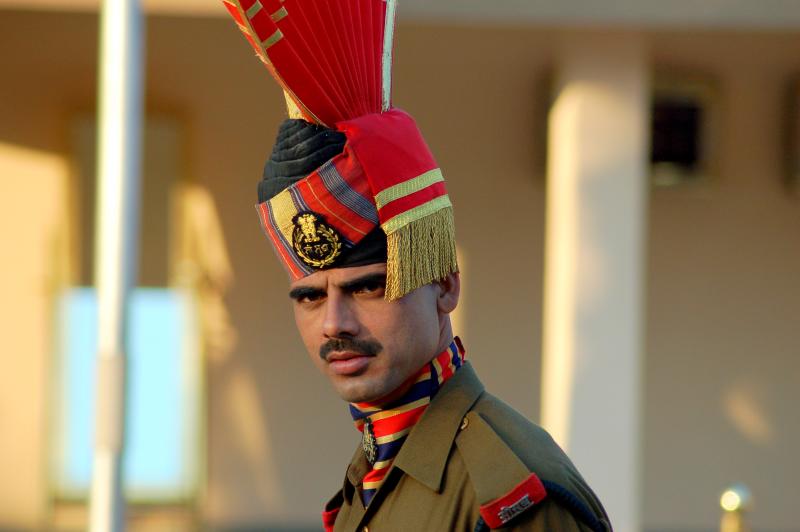
Blank
Blank
Slideshow
Are you a teacher who’s interested in telling this story to your students? Here’s a slideshow you can use to get started.
Math Resources
Learning Activity:
- Linear Equations (High School)
Sample Problems:
-
- Take a look at the Border Post on Google Maps, using the Satellite layer. Estimate how many people can watch the ceremony on each side of the gate. Which country can have the larger crowd?
- In 2017, India built a flagpole on its side that reached 360 feet in height. Five months later, Pakistan raised a 400-foot-high flagpole. How many feet taller is Pakistan’s flagpole? How many meters taller? Does the difference between the two heights change depending on whether you use feet or meters?
- How high is 400 feet? Is there anything in your community that is 400 feet tall? About how many stories is that height?
- Why do you suppose India doesn’t just put in a new, taller flagpole?
- A typical flagpole is about 70 feet tall. A person should be able to raise a flag to the top in about 30 seconds.
- At that rate, how long would it take to raise flags at Wagah?
- If the Pakistanis and Indians raised their flags at the same rate, which would arrive at the top first?
- What assumptions do you need to make for your answer to make sense?
- What would need to happen for your answer to be reversed? That is, if you said the India flag would reach the trop first,what would need to happen for the Pakistan flag to reach the top first (assuming both flags were raised at the same speed)?
Social Justice Questions
Since the 1947 partition, India and Pakistan have fought over the region of Kashmir, which lies between them.
- With both countries having nuclear weapons, any escalating conflict could have global consequences. What do you think should be the role of your country in the relationship between Pakistan and India?
- More than 15 million people live in Kashmir. The majority of them are Muslims—97% according to a 2021 census. Do you think it’s more fair for Kashmir to belong to Pakistan, India, or to be its own independent country? Explain your reasoning.
Explore Further
- More information about the partition of India
- History of Pakistan and India’s relationship
- A story map of the ceremony
- Video of soliders lowering the flags
Share Your Story
Write your own Global Math Story and send it to us!
Sorry, the comment form is closed at this time.